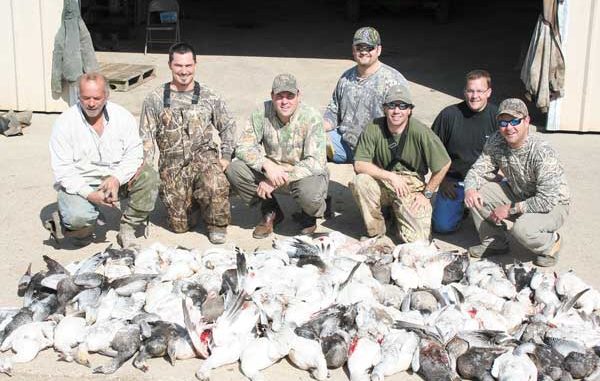
Waterfowlers looking to extend their hunting should take advantage of the special conservation season, which allows hunters to shoot light geese throughout February while using electronic calls and unplugged shotguns.
Bobby Belaire received a call last February from a rice farmer, and he couldn’t believe the opportunity he was offered. “The farmer called and said he had a big flock of geese coming to one of his fields, and he said he had watched them come in three days in a row,” Belaire said. “He said he wanted to get his brother-in-law in on a good hunt.”
That’s all the Rayne hunter needed to hear. He rounded up a couple of buddies to add to the group, and showed up the next morning. The group hurriedly set out a huge spread of decoys and windsocks, and then turned to the job of setting up blinds.
“Just a little after daylight, here they come — wave after wave of them,” Belaire said. “We barely had time to get the lay-down blinds brushed. They (the blinds) looked terrible.”
The big birds spotted Belaire’s spread, and headed straight in. Geese resembled B57 bombers as they dropped toward the hunters, and index fingers slipped into trigger guards after safeties were snapped off.
However, the die-hard goose hunter didn’t call for shots yet.
“When you think they’re in range, you’ve got to wait another five to six seconds,” Belaire explained. “They’re just so big that they look like they’re close enough, especially if you’re used to looking at ducks.”
Belaire yelled, “Take ‘em,” when one of the groups finally slipped low enough, and the hunters snapped shotguns to shoulders as they sat up and fired. Geese plummeted to the ground with satisfying THUNKs.
The hunters quickly dispatched any wounded birds, and then sank back into their blinds to await their next opportunity.
The scenario repeated itself many times that magical morning, with group after group of birds descending into shooting range.
When the birds finally stopped flying that morning, there were piles of geese all through the spread. The hunters had popped more than 90 birds.
“They were feeding in that field, and when they get in a pattern and do something repeatedly, you can really clean up,” Belaire said.
This hunter once lived and breathed duck hunting, enjoying the experience of watching ducks fall into a decoy spread only to fold up and hit the water after well-placed shots. But that was before he found his true calling.
“All I want to do now is goose hunt,” Belaire said. “I don’t know what it is. Maybe it’s that you almost know you’re going to shoot your ducks when you go duck hunting, but when you go goose hunting, you can have everything perfect and scratch.
“I get chills. You just can’t compare it to duck hunting.”
Of course, size also is a factor.
“When they decoy, they’re so big,” he chuckled.
And the special conservation season, when hunters are allowed to hunt with electronic calls and unplugged shotguns, provides hunters with an extended season and opportunities to experience such hunting.
But the reality is that Belaire’s hunt last February was atypical: Even though any goose hunt is usually thrilling, the normal hunt doesn’t provide such hectic action or produce piles of geese even when swarms of the birds are in the air.
“They’ll teach you a lesson,” he said.
In fact, the only way a hunter can expect to knock down dozens of birds is when geese choose his field as a feeding trough.
“The slaughter only happens when you’re in the field where they’re feeding,” Belaire said. “Generally, if we’re in a real good area and we have two or three groups (of birds), we average 20 to 25 birds without the (electronic) caller and 30 to 35 birds with the e-caller.”
Setup can be critical, but oftentimes the birds just don’t respond in predictable ways. That’s when flexibility is mandated.
“If the geese keep doing the same thing, you have to move or you won’t fire a shot,” he said. “You have to adjust. You have to move the decoys. You have to move the blinds.”
Belaire said there are usually lulls of action between flights that provide time for moving around. However, if the birds are coming in steadily and he can’t get them to respond, he doesn’t hesitate to move right then.
“Half the time, you moving around in the spread will attract them,” he said. “They love that movement.”
And sometimes it’s just not meant to be.
“Sometimes you know you’re screwed,” Belaire said. “You can try to put up your fliers and flag at them, and hope some peel off, but if they don’t want to be in your field, not many of them will react.”
Yet Belaire refuses to give up.
“I just love it,” he said. “It’s in my blood.”


